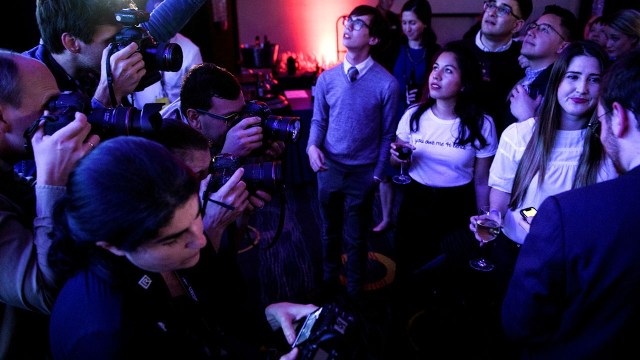
A new study of the images accompanying news stories posted publicly on Facebook by prominent American news media outlets finds that men appear twice as often as women do in news images, with a majority of photos showing exclusively men.
The Pew Research Center analysis used machine vision to examine the representation of women in news images from 17 national news outlets’ Facebook posts from April 1 through June 30, 2018.1 Facebook is a source of news for 43% of U.S. adults, while social media as a whole has outpaced print newspapers when it comes to where people often get their news.
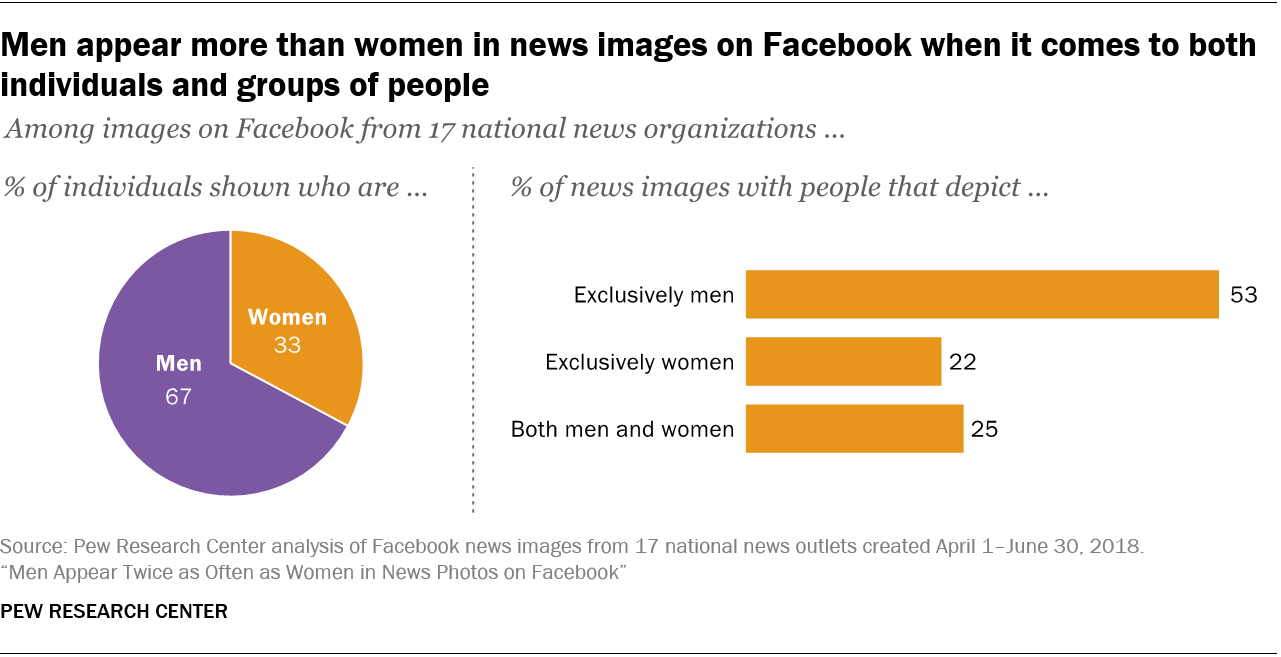
Why Pew Research Center studied news photos on Facebook
Researchers chose to study news images on Facebook because the site standardizes the presentation of news images and text across outlets. News posts that appear in social media feeds like Facebook feature large photographs and contain only a small amount of text and a link to a longer article. In contrast to other formats such as print media, the photograph in a Facebook post occupies more screen space than the accompanying text and is the main object that Facebook users see when they scroll through the news feed. Academic research based on data collected between July 2014 and January 2015 finds that Facebook users only clicked on about 7% of national news, politics and world affairs posts that they viewed in their news feeds. Previous research from the Center has examined how representations of men and women in Google Image Search results can sometimes be at odds with real world data. And academic researchers have leveraged similar tools to study the depiction of women in the news.
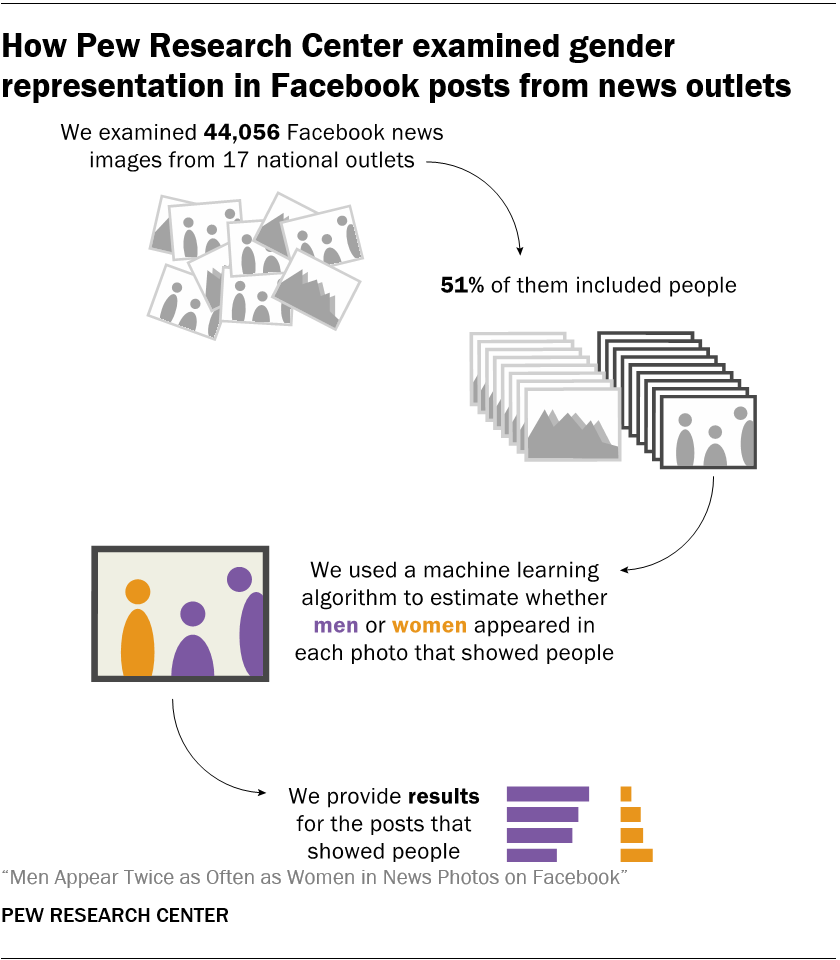
There are several ways to measure how often men and women appear in news photos. One way is to think about all the photos together as making up one big crowd of people and estimating what share are women versus men. Women made up 33% of all the 53,067 individuals identified in news post images, while men made up the other 67%.
Another way to look at the data is to examine the mix of people who appear in each image. Across the 22,342 posts with photos containing identifiable human faces, more than half of them (53%) exclusively showed men, while less than a quarter showed exclusively women (22%). The remaining images (25%) show at least one man and one woman.
All 17 news outlets included in the study showed more men than women in news images on Facebook during the study period. The share of individuals who were identified as women by the model ranges from 25% to 46%, by outlet.
While these findings are striking, there is no perfect benchmark or “true ratio” for how often men and women should be portrayed in news images on social media. Yes, the U.S. population is divided nearly in half, male versus female. But, for example, all the representational coverage of professional football teams would return results overwhelmingly dominated by male faces. Coverage of the U.S. Senate – currently 25% female – might do the same. In addition, the analysis did not address whether the content of the news stories that accompanied the images was more focused on men or women.
The analysis also reveals other ways that men are more prominent in news images on Facebook. In photos that showed two or more people, men tend to outnumber women. And men’s faces take up more space when shown, with the average male face being 10% larger than the average female face across all photos with people.
Selecting media outlets
The 17 media organizations included in the study were selected according to several criteria. These included: whether they conduct original reporting on general topics, whether they primarily covered national news rather than local news, whether the site was for a news organization based in the U.S., and whether their websites received at least 20 million unique visitors in the third quarter of 2018, according to data from Comscore. The study does not include media outlets that focus their coverage on one topic, such as business, politics, entertainment or sports. The study also excludes local media outlets. The full list of sites included in the study appears in the Methodology.
Across several different types of news content on Facebook, women appear in images at a consistently lower rate than men. In posts related to the economy, 9% of images that show people exclusively show women, compared with 69% of images which exclusively showed men. A total of 22% of individuals shown in stories about the economy were women, while 78% were men. For posts about entertainment, women made up 40% of depicted individuals and 27% of news photos exclusively showed women, compared with 42% for photos that showed exclusively men.
This work is part of the Center’s exploration of the ways that new advances in machine vision allow researchers to use a computational model to analyze large quantities of photos. While the technology is not perfect – performance may not be as good as human judgment and could suffer from inconsistency across demographic groups (see Methodology ) – it holds promise in analyzing a large quantity of data online, especially because researchers can measure how well these models perform directly. Overall, researchers used a model that achieved 95% accuracy when tested on a subset of the data it was trained with, and 87% accuracy when tested on a random sample of 998 individuals from the Facebook news images, using human judgments as a ground truth.
Men appear more than women in news photos on Facebook
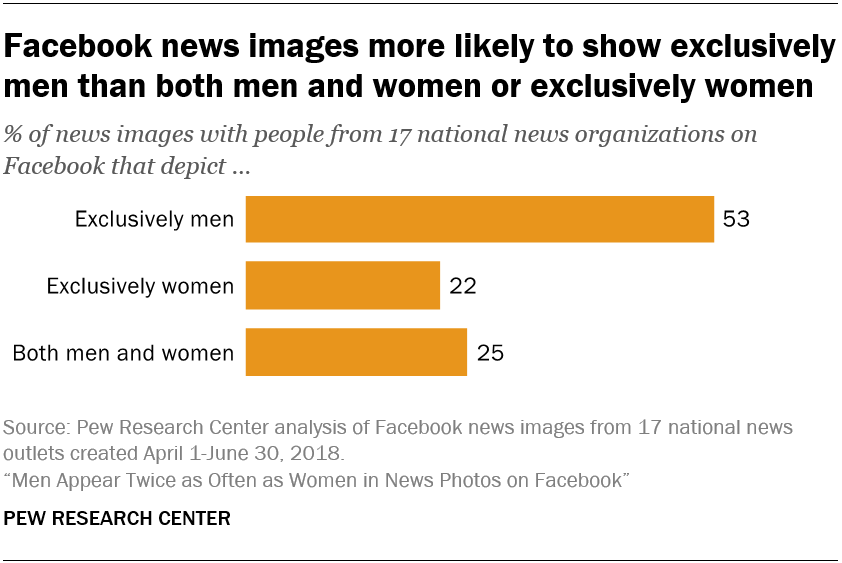
A sizable proportion of the Facebook news images posted by the outlets examined in this study exclusively depict men. Across the news images that showed people, 22% showed exclusively women and 53% showed exclusively men.2 Photos including both men and women were slightly more common (25%) than those that showed women alone.
Overall, researchers identified 53,067 individuals across the 22,342 images from news posts showing people. Of those individuals, 35,367 were estimated to be men and 17,700 were estimated to be women. In other words, 33% of all people shown in news images on Facebook were women and 67% were men.
Over three-quarters of images showed one or more men (78%), while slightly fewer than half (47%) of photos showed at least one woman.
In photos that depicted multiple people, men outnumbered women. The median post with multiple people showed one woman and two men.
Measuring how often men and women appear across photos with multiple people
Calculating the percent of men or women who appear in news photos – among all depicted individuals – is a straightforward way of looking at the data. However, some photos show just one person, while others show many people. Calculating the overall percent of men or women who appear treats a photo of a crowd the same as many individual portraits.
Researchers wanted to be sure that the pattern of men appearing twice as often as women was consistent across photos that showed any number of people. To do so, researchers calculated the average rate that men and women appeared across posts. For example, consider a photo that shows two women and two men, another that shows no women and one man, and a third with two women and six men. Taken together, the average share of women is 25%, based on (50% + 0% + 25%) / 3). In the same example, the average share of men is 75%, based on (50% + 100% + 75%) / 3).
Across all 22,342 photos from news outlets, the average share of women depicted in each news image is 33%, while the average share of men shown per news image is 67%. These numbers match up with the results based on the percent of all individuals shown.
Women are shown relatively more in news about entertainment, but never more than men overall
Men appeared more often than women across four categories of news content on Facebook researchers analyzed, but some categories featured relatively more women. Compared with other categories, women are more likely to appear in news photos for posts about entertainment – defined here as news about TV, music or movies – than in news photos for posts that mention the economy, immigration or sports. However, even across these four topics, women never appeared more often than men within each group of news images.
The four topics researchers selected include two specific policy issues rated as important by substantial shares of U.S. adults (immigration and the economy) and two broader subjects that people seek news about, sports and entertainment.3 These four topics are not exhaustive and were selected because they related to areas of public interest and could reliably be identified using computational methods. See the Methodology for more information about how the topics were selected.
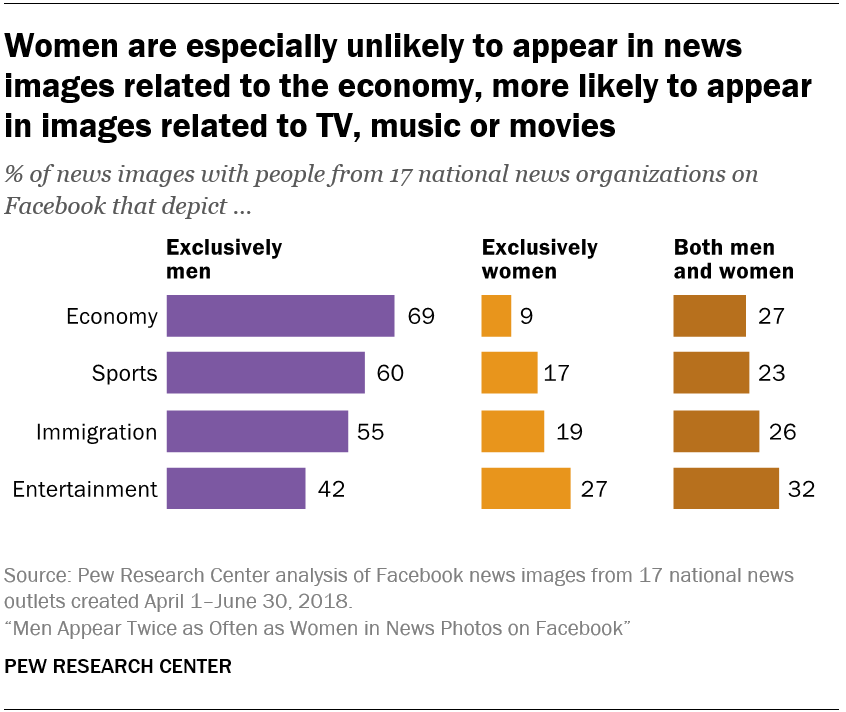
Researchers trained a text classification model to determine which news posts related to these four topics. This kind of model is based on human decisions about which words are associated with particular topics in a sample of posts. The model then makes predictions about whether any of the posts mention those topics. All posts with news photos were included when classifying the content of the posts – those that showed people and those that did not.
The model used text that appeared alongside the post, including its title, caption and comment. Researchers validated the results of the models by asking human coders to examine a subset of posts.4 Looking across all 44,056 posts – whether their images showed people or not – the model predicted that 5,678 posts mentioned entertainment, i.e., TV, music or movies (12.9%), 1,296 mentioned economic issues (2.9%), 1,529 mentioned immigration (3.5%) and 1,302 mentioned sports (3.0%).
The gender gap in posts mentioning entertainment was notably smaller than other topic categories. Women appeared much more often in news photos accompanying these posts than in those accompanying posts that mention other topics. The study found that 27% of posts mentioning entertainment exclusively showed women and 42% exclusively showed men. Overall, 58% of posts in this category showed at least one woman while 73% showed at least one man.
By contrast, posts that mentioned the economy showed the largest gender gap among topic categories, and people depicted in those photos were much less likely to show women. In fact, just 9% of these posts exclusively depicted women, while 69% showed exclusively men. The remaining 22% of images showed both men and women, with only 31% of these posts showing at least one woman – less than half the rate that women appeared in posts about entertainment. And 91% of posts that mentioned the economy showed at least one man.
The gender gap within posts about sports was also notable: 40% of the images with identifiable human faces accompanying those posts depicted at least one woman, compared with the 83% that depicted at least one man. Results were similar — but slightly less pronounced – for posts that mentioned immigration.
These differences also appeared when examining the share of people who were women across posts mentioning each topic. In news posts about entertainment, 40% of depicted individuals were women. That number is 22% for news posts about the economy. In news posts about immigration, 33% of individuals were women. For posts about sports, women made up 26% of people shown.5
Women’s faces appear smaller than men’s in news images
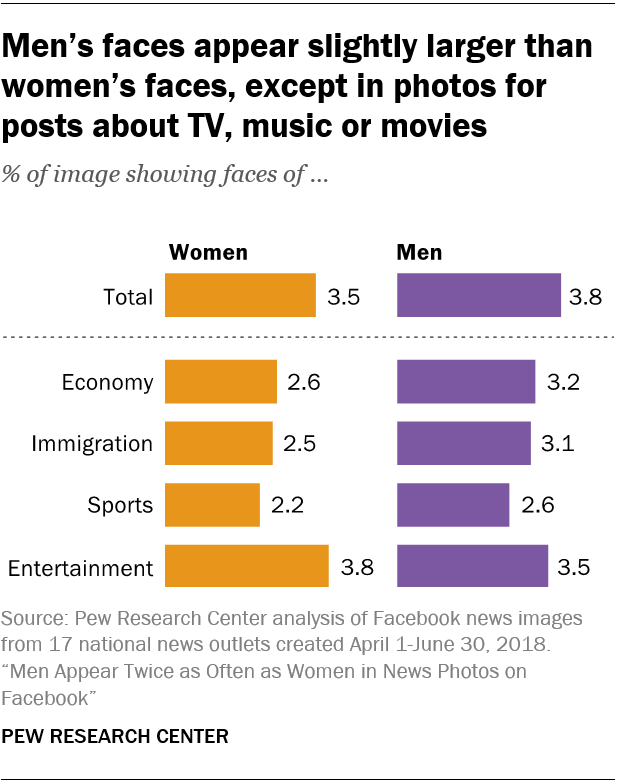
When it comes to how prominently individuals’ faces were depicted in news photos, there was a modest difference between men and women. Researchers measured the size of women’s faces relative to that of men’s faces to capture prominence. The technique researchers used to measure faces only captures the size of a person’s face, omitting features like hair, jewelry and headwear. The average male face occupied 3.8% of an image on average, while the average female face took up 3.5% of an image. These differences amount to the average male face being shown at a size 10% larger than the average female face.
The average size of women’s faces was 19% smaller than the average size of men’s faces in posts that discussed the economy. In posts that mentioned entertainment, women’s faces were 7% larger than men’s faces, on average.
Even among news images that featured multiple people, women had the largest face visible in the photograph for only 32% of images.
Across outlets, women never appear more often than men
On average, none of the media outlets examined in the study showed more women than men in news photos. Among the outlets examined here, the percent of women depicted (among all individuals shown) ranged from 25% to 46% per outlet.
Each outlet created 2,592 posts in the three months between April 1 and June 30, 2018, on average, including all posts, whether their photos showed people or not. The outlet level total varied from 878 to 3,975 posts. A total of 1,471 posts – 3.3% of the full sample – were posted by news outlets multiple times with the same text and image; these posts are included in the analysis.
Out of the 17 media outlets, six showed women more prominently than men, on average, in terms of how large their faces appeared.



